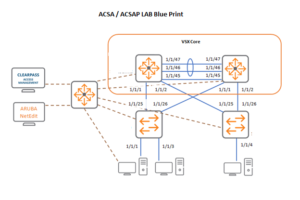Implementing ArubaOS-CX Switching, Rev. 20.21 (ACSP)
____
The Aruba Certified Switching Professional (ACSP) certification is a certification offered by Aruba Networks. This comprehensive course equips you with the advanced expertise required for the successful deployment and management of enterprise-level Aruba campus switching solutions. Building upon your foundational knowledge from the Associate level, you will master the configuration and administration of cutting-edge, open standards-based network solutions using Aruba’s OS-CX routing and switching technologies.
Throughout this course, participants will delve into the intricacies of ArubaOS-CX switch technologies, encompassing essential topics such as fortified port access through Aruba’s dynamic segmentation, the implementation of robust redundancy mechanisms like the Multiple Spanning Tree Protocol (MSTP), strategic employment of link aggregation methods including the Link Aggregation Protocol (LACP), and the mastery of switch virtualization using Aruba’s esteemed Virtual Switching Extension (VSX) and the innovative Virtual Switching Framework (VSF).
With a balanced blend of theoretical instruction and practical application, this course ensures an immersive learning experience. Through hands-on lab exercises and engaging lectures, participants will solidify their understanding, making up approximately 50% of the course each. Embark on this transformative journey to amplify your expertise in Aruba’s advanced switching landscape
Here are some tips for preparing for the Aruba ACSP exam:
- Take an Aruba-certified training course.
- Study the Aruba ACSA exam guide.
- Practice with Aruba exam simulations.
- Take practice exams.
- Set realistic goals and work towards them with discipline.
Who should enroll?
This course is designed for all who are seeking networking career & certification. This course also provides foundational knowledge for all support engineers involved in the basic installation, operation, and verification of Cisco networking devices.
The job roles best suited to the material in this course are:
- level 2 network engineer
- Sr. Network administrator
- Sr. Network support technician
- Sr. Help desk technician
- Introduction to Aruba Switching
Switches overview
Architectures - NetEdit
Overview
Centralized configuration
Switch groups/templates
AOS-CX Mobile App - Network Analytics Engine (NAE)
Overview
Configuration
Core NAE feature lab
sflow, local mirror, remote mirror - VSX
VSF vs. VSX: access and Agg/core design
Stacking review
VSF and uni/multi-packet forwarding
Stack fragments / split brain
VSX Overview: roles, control, data, management planes
VSX components (ISL, Keepalive, VSX LAG, Active Gateway, Active-Forwarding, Link Delay)
Split Brain scenario
Upstream Connectively Options (ROP single VRF, SVIs with multiple VRF, VSX Lag SVIs with multiple VRFs)
Upstream/Downstream unicast traffic flow (South-North and North-South)
VSX Configuration: VSX and Active Gateway
VSX firmware updates - ACLs
Overview: types, components
MAC ACL, Standard ACL, Extended ACL,
Classifier-based Policies
Configuration: wildcard bits, logging, pacl, vacl, racl - Advanced OSPF
Review basic OSPF
Multi-area: setup and aggregation
Area-Types Stub, Totally Stub, NSSA, Totally NSSA
External routes
OSPF tuning: costs, bfd, gr, auth, vrrp, virt link - BGP
Overview: i/e bgp, as numbers
Best path selection
Configuration: route announcement
Route filtering to prevent transit as - IGMP
Overview
Querier
Snooping
Unknown multicasts - Multicast Routing: PIM
Overview
PIM DM - 1X Authentication
Overview: roles, requirements, coa, accounting
Dynamic port configuration: avp, acl, qos, VLAN
Port-based vs. user-based: examples
Radius service tracking, critical VLAN - MAC Authentication
Overview: Use cases
Radius-based MAC Auth - Dynamic Segmentation
Leverage dynamic segmentation features
Configure tunneled-node on AOS-CX switches
Describe when and how to configure PAPI enhanced security, high availability, and fallback switching for tunneled-node
Quality of Service
Overview
VoQ (Virtual Output Queue) - QOS: queueing, QOS marks, dot1p, dscp
Trust levels
QOS configuration: port, VLAN, policies
Interaction with user roles
Queue configuration
Rate limiters
LLDP-MED - Additional Routing Technologies
VRF – Management VRF
PBR
MDNS
PIM SM - Captive Portal Authentication
Overview of guest solutions
Built-in web auth
ClearPass redirect with CPPM
To access our resources please fill up the contact form.
Initial configuration for the above labs
Blueprint
E-books
Study Materials
Our Videos
PPT’s
And Lot More


ACSA Online
40 hours Course- Online 5-Days Classes
- online Part-time evening classes
- Online Weekend classes
- Lab Practice
- Exam Preparation
- Study Materials
© 2014 YashVardhan Information Technologies | Because IT is Future!

